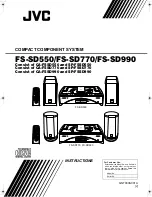
31
-EN
7
Adjust the slope of H.P
.F. (HP SLOPE) by tur
ning
the
Rotary encoder
, and pr ess the
Rotary
encoder
.
8
Adjust L.P .F. by per for ming steps 6 and 7.
9
Adjust the level (LEVEL) by tur
ning and then
pressing the
Rotary encoder
.
Press the
Rotar y encoder
to return to step 6.
10
To adjust other channels, r
epeat steps 5 to 9.
11
When the setting is complete, pr
ess and hold
CENTER f.
for at least 2 seconds.
The unit returns to the normal mode.
Press
CENTER f.
to select another item to be set.
• When the speaker is set to the “OFF” mode, the X-OVER for that
speaker cannot be set. Refer to “Setting the Speakers” (page 30).
• Check the playback frequencies of the connected speakers before
adjusting.
• In order to protect the speakers, there is no OFF setting for the
subwoofer low pass filter (the slope remains the same).
• The H.P.F. filter cannot be set to OFF (slope OFF) if Tweeter is
selected for FRONT1. Or, only the subwoofer is adjustable if
STEREO is selected for the subwoofer.
• When the setting is complete, it is recommended to store the setting
contents. For storing, refer to page 37.
Performing Time Correction Manually (TCR)/
Phase Switching
Because of the particular conditions inside the vehicle, there can be
major differences in the distances between the various speakers and
the listening position. It is possible to calculate the optimum
correction values and eliminate the time error at the listening position
yourself using this function.
Calculating the Time Correction
1
Sit in the listening position (the driver
’s seat, for
example) and measur
e the distance (in meters)
between your head and the various speakers.
2
Calculate the dif
fer ence in distance between the
far thest speaker and the other speakers.
L =
(distance of farthest speaker)
– (distance of other speakers)
3
Divide the distances calculated for the dif
fer ent
speakers by the speed of sound (343 m/s
temperature 20°C).
This value is the time correction value for the various
speakers.
Concrete examples
Calculating the time correction value for the front left speaker
on the diagram below.
Conditions:
Distance between farthest speaker and listening position:
2.25 m (88-3/4")
Distance between front left speaker and listening position:
0.5 m (20")
Calculation:
L = 2.25 m (88-3/4") – 0.5 m (20")= 1.75 m (68-3/4")
Compensation time = 1.75 ÷ 343 x 1000 = 5.1 (ms)
In other words, setting the time correction value for the front
left speaker to 5.1 (ms) sets a virtual distance matching the
distance to the farthest speaker.
Inputting the Time Correction
4
Check that Defeat mode is of
f (page 19).
5
Press and hold
CENTER f.
for at least 2 seconds.
The audio processor control mode is activated.
6
Select the TCR/PHASE mode by pr
essing
CENTER f.
repeatedly .
7
Select L+R or L/R by pr
essing and holding
BAND
for at least 2 seconds.
L+R:
Sets the same adjustment values for the left and right
channels.
L/R:
Different adjustment values can be set for the left
and right channels.
Continued
2.25m
0.5m
5.1ms
The sound is uneven
because the distance
between the listening
position and the different
speakers is different.
The difference in the
distance between the front
left and rear right speakers
is 1.75 meters (68-3/4").
Time correction eliminates
the difference between the
time required for the sound
from the different speakers
to reach the listening
position.
Setting the time correction of
the front left speaker to 5.1
ms makes it possible to
coordinate the distance from
the listening position to the
speaker.
Содержание DVA-9860R
Страница 64: ......
















































